Fever and children: dangerous couple?
Fever in extrahospital pediatrics is the cause of one-fifth of the total number of consultations (20.9%), the first position being cough. In children under one year of age fever is the second cause of consultation, behind routine medical studies (control of food and development, vaccines, etc.) and the cough. In addition to these statistical data, fever is one of the most frequent reasons for emergency telephone calls and consultations.
What is fever?
The regulation and control of body temperature is mainly done by the thermoregulatory center located in the hypothalamus, supplemented in other places. In the center of the brain, this center located between the two hemispheres, is formed by other smaller units and is responsible for maintaining our temperature stable by a complex mechanism. When these mechanisms are modified or mixed, the temperature increases and that is what we call fever.
The clearest sign that fever is a self-regulated phenomenon is that it does not rise above 42°C (in the rear) and below 41 degrees rarely.
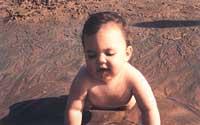
But the increase in temperature does not necessarily mean illness. The temperature has a circadian rhythm, approximately daily, in which variations of 0.25-0.8 degrees occur between six in the afternoon and three in the morning. In the evening the temperature drops, reaching its lowest level at three in the morning, and from there it increases gradually, reaching the highest level around six in the afternoon. This rhythm varies from person to person and does not exist in newborns, since it is launched towards the second year. Except in the neonatal period, the body temperature of children is slightly higher than that of adults, probably due to their greater relative body surface and their greater metabolism.
Physical exercise can also significantly increase temperature and other factors that can cause changes would be the intake of ambient temperature, emotional alterations and protein-rich foods.
Many and very different are the causes of fever. Infections are, of course, the most frequent, but there are other diseases that are not infectious and capable of producing fever.
How to take the temperature?
The first historical reference of the use of the thermometer to measure body temperature dates from 1870 and was described by Wunderlich. Since then, different types of thermometers have been appearing, and at present there are three that are commonly used: the already traditional mercury, the plastic strips that change color by changes in temperature and the electronic thermometers or digital reading that have been becoming increasingly current in recent years. The most reliable of these three types are mercury and electronic, since plastic strips, despite detecting temperature changes, do not give us accurate figures.
Maintenance time of the thermometer is very important, which will logically vary depending on location.
Many mothers are very fond of their ability to know the temperature of the child only with the simple change (touching with the palm of the hand, the Scotch or the lips the front of the child or other parts of the body). In a study carried out in 1974, Bergenson detected errors in 42% of the evaluations thus performed. Therefore, it can be claimed that this system is not reliable for determining body temperature.
Where the temperature is taken?
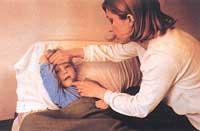
The most common points for taking body temperature are the mouth (under the tongue), the armpit or armpit and the rectum (anus).
Oral temperature
It should not be tried to take the temperature in the mouth before 5 or 6 years, and for this it is necessary for the child to accompany properly.
The location must be exact (under the tongue) and there the thermometer should be placed one minute or more, except the electronic one (these are “faster” and the temperature reached is 0.5 degrees (5 tenths) lower than the one taken in the rear. It is important to know that hot or cold foods can produce oscillations of one or two degrees. Therefore, it is recommended to perform the measurement as far away as possible from meals.
Axillary temperature
In a work done in 1984, Kresch discovers that the axillary temperature is very variable and is not sensitive to measuring fever. The ability to give an adequate value is scarce and takes about eight minutes to record the temperature with a mercury thermometer, but not with the electronic thermometer. Above and against everything said by Kresch, the armpit is the most common location to take the temperature in children over a year. That is why it is worth saying what is the right technique. The mercury ampoule or electronic thermometer sensor should be placed in the fold that occurs between the arm and chest. The arm should be crossed with the chest to the opposite shoulder and held if the child does not help properly (5-8 minutes in the case of mercury thermometer).
The axillary temperature can be a grade lower than or below that of the year.
Temperature of the ass
This is the best indicator of body temperature and undoubtedly the most recommended place is the rectum, especially in children under one year. The risks of the technique are very small, and the accidents are due to the rupture of the mercury column (while the thermometer was inside the child's ass) and to perforations by inadequate techniques. The use of electronic thermometers has avoided, despite its extreme difficulty, the risk mentioned.
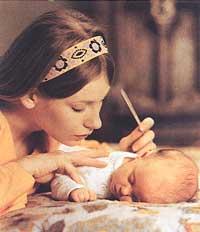
If you opt for this method, you must insert the thermometer about five centimeters into the straight channel, carefully, making a reading at 2-3 minutes. With the child face down (for example on our knees), separating with one hand the cheeks from the buttocks and putting with the other the thermometer in the ass, we close the cheeks of the buttocks, keeping the child hard until the time of reading the temperature (to avoid sudden movements).
References to temperatures in the mouth and underarms are always at the rectal temperature. The pediatrician, therefore, is very used to finishing when his mother told him the temperature of his baby, with a phrase like this: “I discounted five tenths, since I placed the thermometer in the ass.” As we have seen, the difference can be 5-10 tenths. Therefore, when comparing the temperatures in different places.
What is the normal temperature?
It is not easy (it can also be said that it is impossible) to decide what are the limits of body temperature, as with other physiological data. However, in baseline conditions it is considered that the normal temperature in the year is about 37.5 degrees, always taking into account the variations mentioned above, since it is only about oscillations within the normality.
How is it treated?
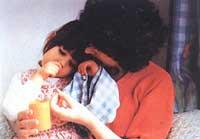
The severity of fever within the family causes parents to consider their treatment more urgent than the cause that produces it. Many times, in addition, they think that fever necessarily needs an antibiotic and from the beginning they want to use one of them without consulting the doctor. Today it is not entirely clear whether the fever is “friend” or “enemy”; if it can be an evolution of the cause that has originated it. Therefore, it is not yet clear whether the fever should be treated or not.
However, there are several suggestions for treating fever. As the temperature reduction can also be achieved by drugs and without medicines, we can be quiet considering that fever (upper ass temperature of 37.5-38ºC) is not dangerous for the child (if it does not exceed 41º C, this is very rare). High fever does not necessarily mean seizure, as these processes will only appear in children with a previous trend (very low percentage). In these cases, the pediatrician will take the necessary measures according to the cases.
Although we accept all these comments, and it is not too little, it may happen that the child with high fever is in poor condition, poorly located. In this case (high fever + bad body) are summarized below some of the measures that can be taken. Offer water or other liquid, little but often. The most curious child asks for it, but you have to be very attentive with young children (risk of dehydration), removing clothes from the child, since the excess of clothes and blankets make the temperature difficult. It is also very useful to refresh the child with a sponge soaked in warm water (forearms, legs and forehead mainly). Rubbing by cologne or alcohol is always very dangerous because it reduces blood glucose levels and can come cone.
If the child's temperature is still high, can be placed in the bathtub always in warm waters avoiding cold water, since the sudden cooling would cause chills and the temperature would rise again.
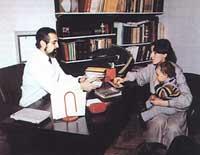
In addition to these domestic measures (although domestic, but certainly beneficial), the pediatrician emits some type of medicine (called ANTITHERMAL) to reduce fever, if possible orally, the Suppositories will be left in case of vomiting.
The drugs for fever are very varied, but today one of those trends is that acetyl-salicylic acid (ASPIRIN, so to speak, all to understand it) is left only for children over twelve years of age, and especially for those who want to fight not only against antithermal action but also against inflammation. And why? For the relationship that can exist between the aspirin and the system of Rey.
As indicated above, fever is not dangerous, except in special circumstances and conditions, but should be considered as a sign that warns us that something is not in the child's body. There will probably be some infection, with a higher temperature not necessarily higher. And we will try to find the reason as soon as possible, by consulting our usual pediatrician or going to the emergency department that has indicated us.
Buletina
Bidali zure helbide elektronikoa eta jaso asteroko buletina zure sarrera-ontzian











